Ever since I was 10 or 11, I’ve dreamed about living in an RV. The idea of having all my equipment with me, ready to go anywhere I wanted at a moment’s notice, seemed too good to be true. Of course, at the time, it mostly was too good to be true. Solar panels were extremely expensive, batteries stored very little energy, and high-speed wireless internet access was practically still the stuff of science fiction.
Over the next decade and a half, that all changed. The proliferation of smart devices meant huge leaps in both cellular networking speed and lithium battery availability. Solar power became much more affordable. YouTube tutorials became ubiquitous, and suddenly anyone could find dozens of guides demonstrating how to take advantage of all these technologies.
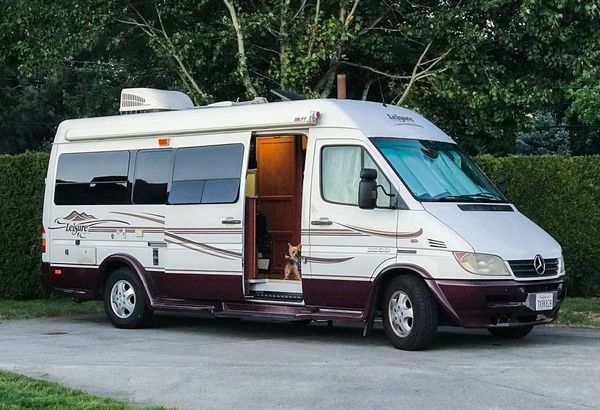
By the time 2017 rolled around, I was fortunate enough to have a fully-remote job in software engineering. At that point, my wife and I had tossed around the idea of living in an RV for a couple years, and we finally decided this was the right time to give it a shot.
After lots of online research and visiting an RV show for some hands-on, we were firmly settled on getting something based on the Mercedes Sprinter chassis (aka a FedEx van). We found a good deal on a used 2006 Sprinter conversion (Leisure Travel FS210B) that had been a rental for the last decade, bought it, and immediately headed up to Portland with our two dogs in tow.
On our way back home from that inaugural trip, the engine exploded.
Space
Despite what you may have seen on Instagram, #vanlife isn’t all glamour. At the end of the day, you are literally living in a van. The extended wheelbase Sprinter is just shy of 22 feet long.1 This is great, because it can fit comfortably in most parking spaces. Spaces in the United States tend to be around 20 feet deep, and the extended wheelbase lets you back in several feet over the edge of parking lots or other unusable areas.
The size is great for parking, but also makes for a truly tiny home. Inside, the Sprinter is 91 square feet.2 Actual floorspace (including fixed seating areas and bed) is just over 60 square feet.3 It took many years and many moves to get to this point. Outside the van, we also rent a 25 square foot4 storage unit, and I’ve stored a few things like vinyl records and instruments at my parents’ house. Even with all the reduction in “stuff”, we’ve still had to squeeze every inch of space out of the van.
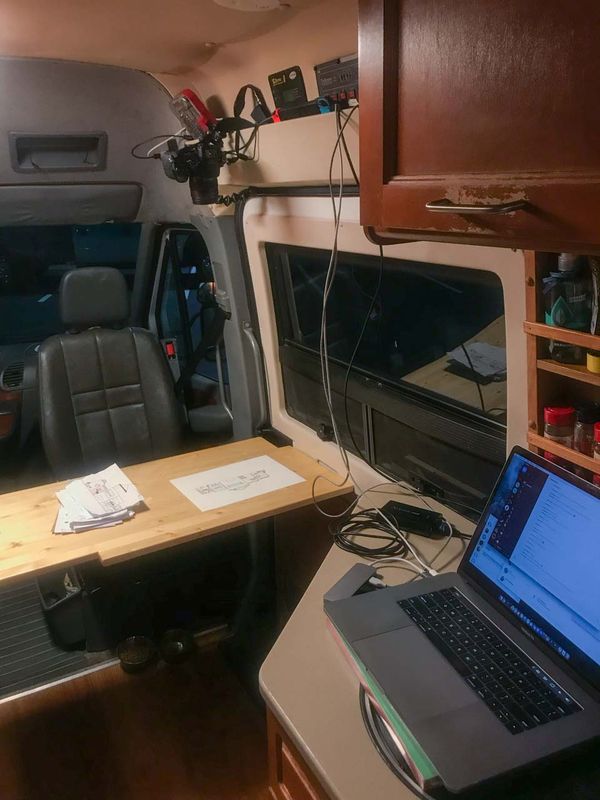
Leisure Travel’s conversion originally had an electric sofa in back that folded down to become the top part of the bed. We kept that system for around a year after moving into the van full-time, but eventually removed the sofa and replaced it with a permanent mattress running sideways in the van. This has worked pretty well for us, but would probably be quite uncomfortable for anyone over ~5’6”.5
Changing the bed layout gave us a permanent and more comfortable sleeping surface, easier access to the back of the van, and more under-bed storage space. Some of the freed up space toward the front of the van was repurposed into a cabinet, which provides a work surface, permanent dog bed, and additional storage.
In front, I added a folding desk to take advantage of the passenger captain’s chair. The desk was originally designed to sit on the rubber stopper for the passenger sliding door, but I later modified it to allow hanging from some hooks above the door. This allows the door to be freely opened and closed while the desk is in use.
Electricity
One of my main goals during planning was to reduce resource usage as much as possible. The fewer resources needed to keep running the van, the more flexibility we’d have when deciding where to stay, and for how long. Of course, we didn’t have much control over water storage since the van had already been converted, but electricity was entirely up to me.
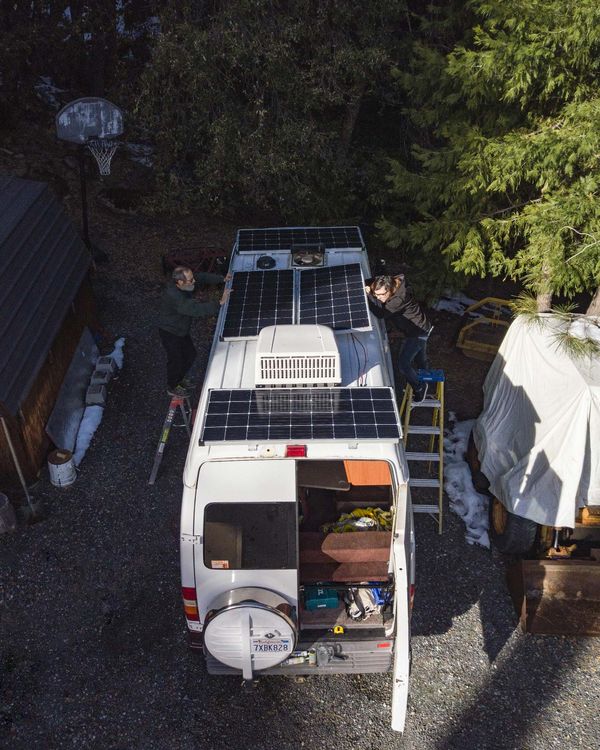
Solar & Battery Bank
You can only fit so many watts of solar panels on the roof of a Sprinter. I was able to fit four 170-watt panels, for a total theoretical 680 watts maximum. That’s not a lot of daily generation to deal with,6 so reducing electricity usage wherever possible was critical if we wanted to avoid having to frequently plug in for charging.
Of course, solar panels are only half of the story for off-grid setups. Just as important is where you store energy generated by those panels for use during dark nights and cloudy days. Our power storage is four 12 volt, 100 amp hour LiFePO4 batteries, for a total of 400 amp hours. There’s all sorts of advice around how to optimally charge and discharge lithium batteries, but I’ve gone with 70% usable for my calculations. This gives 280 usable amp hours per charge, or ~3.4 kilowatt hours.
Lighting
When calculating electricity use, it’s really amazing how quickly small inefficiencies add up. The original conversion included six halogen can light fixtures underneath the cabinets.7 Each halogen bulb used 10 watts, which means running those lights for six hours in the evening would use 360 watt hours, or over 10% of our battery bank’s usable capacity!
The overhead lights were similarly wasteful. Each of the three fluorescent fixtures used ~27 watts, nearly three times more than each of the halogen bulbs. I replaced the overhead lights with LED bulbs, which dropped their energy usage about 50%, to 14 watts each.
I’ve loved controlling lights remotely for about as long as I can remember. My childhood bedrooms often had strings taped to lightswitches, draped around makeshift furniture-pulleys so I could turn them on or off from bed. As I got older, this transitioned to an interest in home automation, and I jumped on the Phillips Hue bandwagon pretty early on. Customizing light colors and controlling them with my phone was definitely something I wanted to maintain in the van.
To scratch that itch, I decided to replace the under-cabinet lights with HomeKit-compatible LED ones. Adafruit’s 12-LED RGBW NeoPixel Ring happened to fit perfectly inside the existing fixtures, so I just removed the old bulbs. To tie everything together, I used a Raspberry Pi running HAP-NodeJS to integrate with HomeKit, and a simple Python script to actually communicate with the lights.8 The new lights have full color and brightness control, and only use about one watt each when on full brightness (usually a lot less, our standard evening setup averages around 2-3 watts). It’s a huge energy savings with lots of additional functionality.
Energy Conservation
To avoid DC to AC conversion losses (something like ~10%), we run as much as possible directly off 12 volt power. To help with this, I’ve added five 12 volt “cigarette lighter” accessory sockets, for a total of six running off the “house” battery bank. Five are in the back of the van, and one is in the cab. USB-C, and especially USB-C PD, have been a huge help in keeping things DC. All of our electronics other than Charlene’s laptop can be charged with either USB-A (“normal” USB), USB-C, or proprietary 12 volt adapters.

The only things that permanently run off AC power are our refrigerator, my wife’s laptop charger, our TV, and an Apple TV.9 Those are all hooked to a Victron Phoenix 12/500, which runs 24/7. The AC electrical panel is powered by a Victron MultiPlus 12/3000/120, which is primarily used for shore power passthrough and battery charging. When we’re on the road, we only turn it on to run higher-power devices like hair dryers. Running the larger inverter constantly would raise our energy usage due to its higher zero-load wattage.10
I highly recommend all of Victron’s equipment. In addition to the two inverters, we also use their Victron SmartSolar MPPT 100/50 solar charge controller, and Victron BMV-70211 battery monitor. All of their products have been very reliable, well-documented, and even frequently updated (both device firmware and iOS app). It’s been very useful to see historical solar yield while on the road.
By far the largest electricity consumer in the van is the refrigerator. I installed a Frigidaire residential mini-fridge, which has an estimated yearly electricity use of 265kWh.12 I ran a few short tests with a Kill A Watt after installation, and that estimate seems fairly accurate, or possibly a bit on the high side.
Aside from a couple periods of multi-week heavy clouds, we’ve been able to comfortably maintain a charge just from solar power from around spring through fall in the United States. This only applies when the van is in fully or mostly-open areas. Shady spots are great for keeping the temperature down, but wreck solar yields. As of this writing, we’ve been staying at a very shady spot in Portland for the last several months, and only yield ~250-350Wh on sunny days. Sunny days in open spots give much higher yields of >1.5-2kWh.
Internet Connectivity
Since I’m a full time remote software engineer, consistent internet access is critical for me. Our primary internet access since moving into the van has been through the Verizon network. This has worked incredibly well, and we’ve had reliable service in the vast majority of spots across the country.
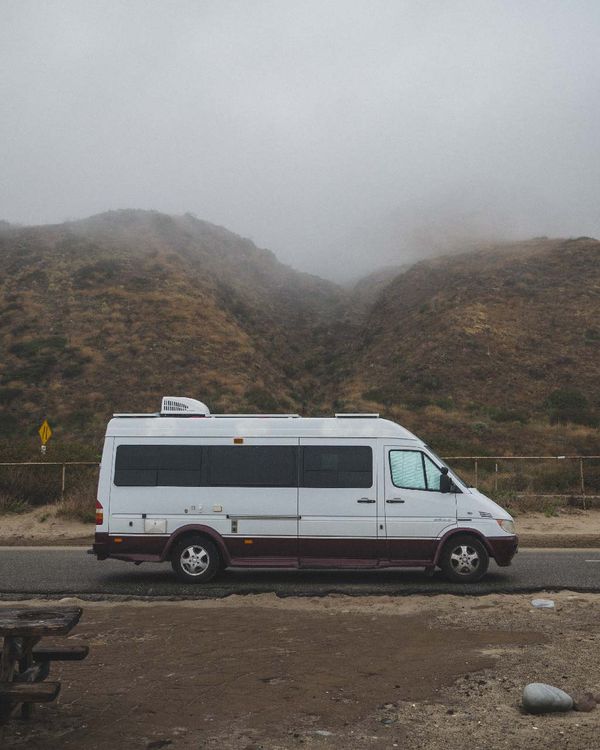
Originally, we had this service through a company called Unlimitedville. They provide unlimited access to the major US networks with no throttling, and we consistently used hundreds of gigabytes of data each month without any issues for around a year. The only downside is that their service is quite expensive; we paid $250/month. In late 2018, we switched to a Verizon unlimited prepaid plan that also offered unlimited data, but for $65/month. Unfortunately, this plan was grandfathered in 2019, and is no longer available to join.
When traveling in Canada, we tethered to my phone. We have Cricket service, which allows for normal use of your plan in Canada and Mexico. My current plan has 10 gigabytes of tethered transfer,13 which is enough to get work done for a good while.
We started out using the Netgear AC791L and MiFi 8800L modem/routers for internet access.14 For the most part they worked okay, but both were extremely prone to overheating. It seems like they definitely aren’t designed for extended use, or even to remain plugged in for an extended period. Eventually I decided they were too big a potential fire hazard to keep using constantly, and replaced them with a MoFi 4500. It’s much more configurable, has ethernet ports,15 and hasn’t had any overheating issues.
If you’re looking into options for cell data plans, or equipment like modems or boosters, I recommend checking out the Mobile Internet Resource Center. They’ve got lots of great articles and reviews, and really keep on top of the industry. They also make an iOS and Android app called Coverage? that I used many times throughout the trip. It was surprisingly accurate for the most part.
Miscellany
There have been tons of miscellaneous projects, challenges, and learning experiences in improving and living in the Sprinter. I’ll go over a few of them here, but there are lots that didn’t make the cut. Just because it’s on wheels doesn’t mean you’re free from basic “homeownery” tasks and maintenance, either (hello re-caulking a bathroom).
The fridge has worked quite well for the most part, and seems to be holding up after 18 months. Its temperature isn’t always as consistent as would be ideal. To keep it cool enough, it has to be set so low that we sometimes end up with frozen items in the refrigerator compartment. This fridge was designed for residential use, and has a built-in childproofing lock. I modified the lock to have a permanent rotating key attached, which makes it easy to secure before driving.
Water storage in the van is quite limited. It has a 26 gallon fresh water, 21 gallon gray water, and 10 gallon black water tank. While traveling, we consistently needed to fill up on fresh water and dump gray about every three days. The black tank generally needed to be dumped around once per week. Going into owning the van, I wasn’t sure how I would feel about the dumping process, but it’s really not bad to deal with.
When we got the van, the Dometic kitchen faucet was damaged, and would often spray water out of the side. The entire fixture is cheap plastic that according to other reviewers is very prone to breaking. Unfortunately, as with many parts made for RVs, it’s still wildly overpriced at around $125. In addition, due to the way the faucet head is oriented, it pointed directly out of the sink basin in the “open” position. We just lived with these frustrations for quite a while, but I eventually realized that the existing head just had standard 1/2” threads, and built a simple PVC replacement that has solved all of our issues with the original fixture head.
Keeping cool was a major challenge during our travels. Since we were often off-grid, we were rarely able to run the air conditioning unit that came with the van. We kept it for a while and used it only when plugged in, but then in winter 2018 removed it and replaced with a Maxxair MaxFan 5100K. This has worked out great so far, even during a few 95º F16 days - admittedly parked in the shade. We don’t plan to take the van on trips during intense heat again, as even with the AC it could get pretty miserable.
The other side of climate control is insulation. We purchased a roll of Reflectix early on, and cut it to make covers for the front windows. To mount the window covers, we sliced slots into the edge of the Reflectix, inserted neodymium disc magnets, and sewed them in place with standard black edging. These have held up and worked very well, and cost very little to make.
The Reflectix panels take care of both insulation and privacy for the front windows. The back windows are all tinted, providing daytime privacy. For nighttime, we got roller shades from MCD. They’re made of a high-quality material that completely blocks any light from getting through, but need frequent adjustment to avoid becoming stuck or very slow.
Back to That Engine
On the way home from our first trip after buying the van, the engine threw a rod. It was the 4th of July, but after a couple hours (and two tow trucks), we were able to get towed into Red Bluff, the nearest town. Of course, everything was closed, but we were dropped off outside a local mechanic where we could spend the night.17 Thankfully, everything worked out, and we were able to get the engine replaced to get the van back on the road (after quite a few weeks; we got a rental car to get home in the meantime).
After lots of cleanup and prep work,18 we moved into the van full-time in late 2017. After traveling the United States and Canada, we spent some time in California before finally taking the van back to Portland in early 2019.19 We stayed at the RV park for about six months, before getting a house in the area in September 2020. I’ve always wanted to try living in a van, but am still a bit surprised it worked as well and as long as it did.
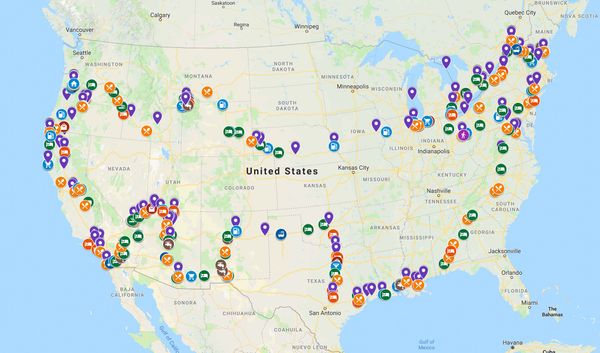
So, what did I learn from this admittedly somewhat ridiculous venture? First of all, I really like the much smaller than average space. No matter what size my living space is going forward, I want to apply the same drastic minimalism to my thinking as has to be applied to live in the van. That being said, I’m very much looking forward to a normal desk/workspace, and a full-size shower.
As I’ve already talked about in detail above, I really like being more conscious of my resource usage. I think a lot more about my water and electricity use, and garbage production than ever before. When your use of a resource has such a direct impact on your daily life, it really helps to put the importance of conservation into perspective.
Even with all the rough patches and frustrations, I’m still very happy to have tried this. I learned tons about several different disciplines, saw huge chunks of North America that I’d never even been near before, and kid me finally knows what it’s like to live in a van.
🚐 ★★★★☆
- 6.7 meters↩
- 8.5 sq meters↩
- 5.6 sq meters↩
- 2.3 sq meters↩
- 1.7 meters↩
- Typical residential PV systems tend to be between 5-10kW, or ~7-15 times larger than this one.↩
- Well, six mounting holes anyway. One of the actual fixtures was missing. #rentalvanlife↩
- This project came together surprisingly fast and smoothly! Unfortunately, electrical noise from the fridge compressor turning on and off kept interfering with the data line of the fixtures that ran behind it, causing them to randomly turn on. This was a minor frustration during the day, but could be quite annoying at night. I tried several solutions with varying degrees of success. Coax grounded at both ends of the run was by far the best thing I tried, but once in a while, the fridge shutting off would still very dimly trigger one of the fixtures. I eventually just rerouted the cables to run the other direction, avoiding the fridge entirely, and haven’t had any issues with interference since.↩
- Since the Apple TV is always on, it can act as a HomeKit home hub for the Sprinter “house” I have set up to control the lights. This means I can control them and any other HomeKit accessories I add from anywhere in the world as long as both I and the van have internet access!↩
- 20 watts vs 9 watts, or 264 extra watt-hours per day - nearly 8% of our total usable battery capacity!↩
- Although I’d highly recommend getting the [BMV-712] (https://www.victronenergy.com/battery-monitors/bmv-712-smart) instead, which has Bluetooth support built-in. I ended up getting the Victron Bluetooth adapter for the 702 - it’s super useful for both configuration and monitoring!↩
- ~730wH per day, ~21% of our usable battery capacity↩
- Before being throttled to 128Kbps↩
- Two is one, one is none↩
- Sadly just 100Mbps↩
- 35º C↩
- We ended up getting takeout from Denny’s, and watching fireworks from the river.↩
- …and several other mechanical issues which I’ll spare you. 🙃↩
- During these trips, we used Campendium extensively. It’s a great resource for finding both free and paid spots to stay the night everywhere in the contiguous United States and the parts of Canada we visited.↩